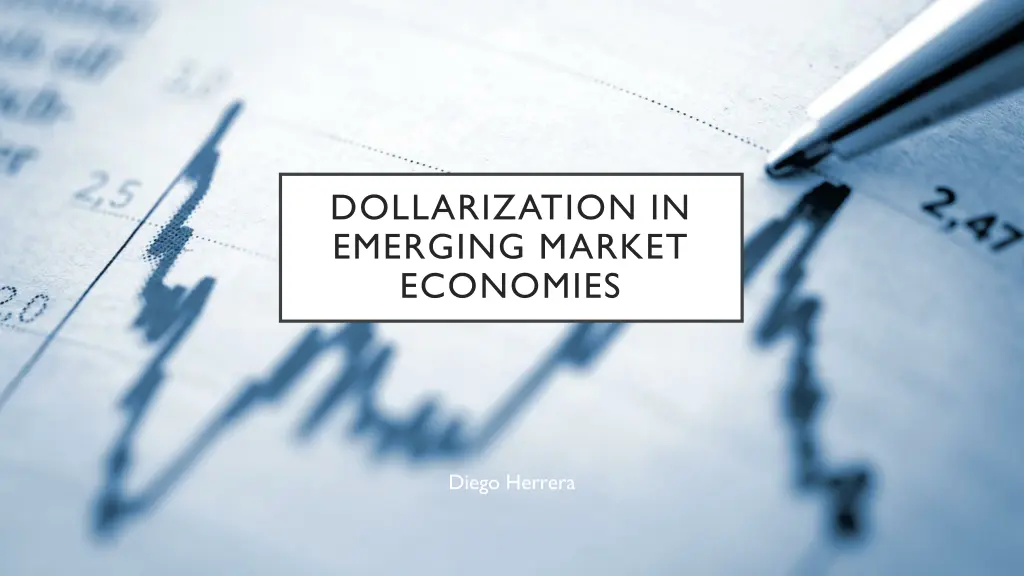
Dollarization in Emerging Economies: Overview and Causes
Explore the concept of dollarization in emerging market economies, featuring insights from experts like Gaetano Antinolfi and Todd Keister. Discover the reasons behind the interest in dollarization, its potential benefits, and the impact of financial crises on these economies. Uncover the anatomy of an emerging market crisis and the challenges associated with floating exchange rates.
Download Presentation

Please find below an Image/Link to download the presentation.
The content on the website is provided AS IS for your information and personal use only. It may not be sold, licensed, or shared on other websites without obtaining consent from the author. If you encounter any issues during the download, it is possible that the publisher has removed the file from their server.
You are allowed to download the files provided on this website for personal or commercial use, subject to the condition that they are used lawfully. All files are the property of their respective owners.
The content on the website is provided AS IS for your information and personal use only. It may not be sold, licensed, or shared on other websites without obtaining consent from the author.
E N D
Presentation Transcript
DOLLARIZATION IN EMERGING MARKET ECONOMIES Diego Herrera
DOLLARIZATION AS A MONETARY ARRANGEMENT FOR EMERGING MARKET ECONOMIES Authors: Gaetano Antinolfi and Todd Keister Overview of emerging literature on dollarization that points out issues that require further research. Discusses the causes of the late 1990 s surge of interest in official dollarization and the potential costs and benefits of dollarizing.
GAETANO ANTINOLFI Professor of economics at Washington University. Visiting scholar at the Federal Reserve Bank of St. Louis. Research Specialization: Macroeconomics; monetary and international economics. Ph.D. from Cornell University.
TODD KEISTER Professor of economics at Rutgers University. Former professor at ITAM (Mexico), University of Texas in Austin, New York University, and the Paris School of Economics. Research Specialization: Macroeconomics; Banking and Financial Stability Ph.D. from Cornell University.
FINANCIAL CRISES Interest in official dollarization is largely a reaction to recent string of currency crisis. Currency crisis are not costly in terms of lost output for industrialized economies but they are extremely costly for emerging economies. Ex: In 1995 Mexican real GDP declined by 7% . When an EM economy suffers a crisis, others are often hit by interest rate increments and a recession, this know as contagion. Ex: Argentina followed the Mexican crisis.
ANATOMY OF AN EM CRISIS 1. Incipient capital inflow and a current account deficit. 2. Sudden capital outflow. 3. Large devaluation of the exchange rate. 4. Crisis in the banking system. 5. Result is a sharp and painful fall in output.
THE FEAR OF FLOATING Flexible exchange rate: price of a currency is determined by the market without any central bank intervention. In this case a current account deficit has to be financed entirely by capital inflows without any change in official reserves. Few countries have purely flexible exchange rates. Capital flow volatility causes volatility in exchange rate, which means volatile prices that disrupt real economic activity. EM economies are averse to floating exchange rates due to: High levels of dollar-denominated debt. High exchange rate pass through (reflected in inflation). Adverse effect of currency instability on credit market access.
THE COSTS OF CAPITAL CONTROL Capital controls avoid capital market volatility. Capital controls such as taxes and reserve requirements can change the composition of capital inflows in favor of long-term investments. CC are considered weak economic policy because: Limit the ability of a country to borrow and invest. Complicate international risk sharing and technology transfer. Prolong the survival of unsustainable domestic policies. Create incentive for tax evasion and require a costly enforcement apparatus.
SEIGNORAGE REVENUE Dollarization entails losing seignorage revenue that comes with the power to print fiat currency. A dollarized economy has to buy back its domestic monetary base using foreign reserves, therefore loosing the interest on its reserves. Chang and Velasco argue that the benefits of lower inflation outweigh the value of the revenue that higher inflation brings through seignorage revenue. Loss of seignorage revenue can be offset in two ways: 1. Negotiate a deal with the US under which the country receives some of the increased US seignorage revenue. 2. Increased tax revenues from increased economic activity caused by economic stability.
FISCAL CONSEQUENCES Due to loss of seignorage revenue and independent monetary policy, dollarization has important consequences on fiscal policy. Dollarization may be used as a tool to solve anticipated inflation caused by fiscal policy. Dollarization might decrease incentives for fiscal discipline by allowing costs of present fiscal looseness to be shifted to the future. Dollarization might decrease incentives for fiscal discipline by increasing capital inflows and increasing political pressure caused by domestic interest rates.
ECONOMIC INTEGRATION Potential benefit of dollarization is that it could increase the level of integration of the dollarizing economy with the US economy. Higher trade is caused by reduced transaction costs and the elimination of exchange rate uncertainty. Financial integration with the US in terms of supervisory and regulatory policies.
THE LENDER OF LAST RESORT FUNCTION Common argument against dollarization is that it would limit the ability of the CB to act as a lender of last resort. However, literature shows this is overstated because: 1. The ability of a CB to act as a lender of last resort is equally limited under fixed exchange rates and currency boards. 2. CBs in industrialized economies do not generally perform this function by printing currency; they borrow instead. 3. There can be an international lender of last resort. 4. CB might not take right action due to political pressures.
THE EFFECTS FROM THE PERSPECTIVE OF THE UNITED SATES Two areas where a large dollarization could have a significant impact on the US: 1. Seignorage revenue 2. Conduct of monetary policy US receives seignorage revenue from the dollarizing economy. Money can be set in a lender of last resort fund. Financial integration may be beneficial for the US as well. The US might loose monetary independence as well (Mexico example).
Use of a foreign money also implies that the domestic government is relying on the foreign government to maintain better control over the inflation rate than it does itself an admission that most governments would be reluctant to make. And besides, who is to guard the guardians?


